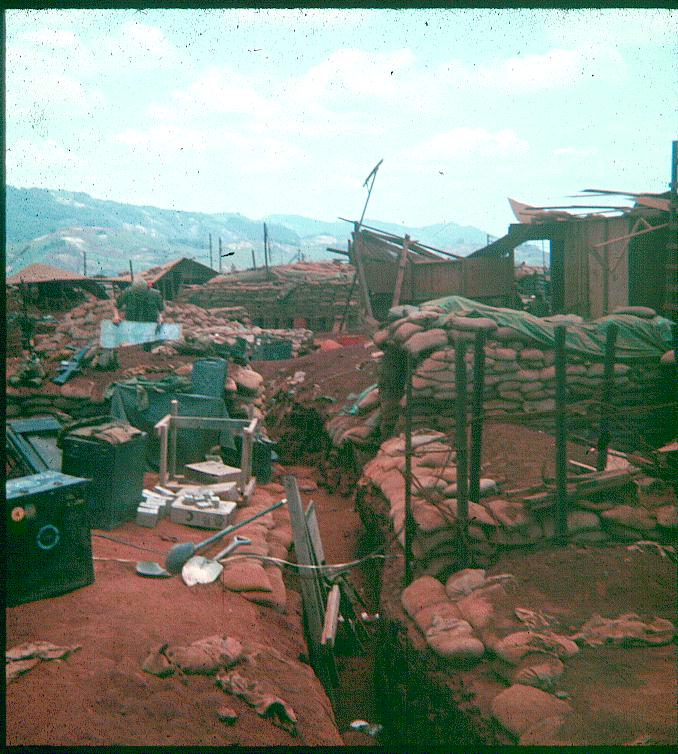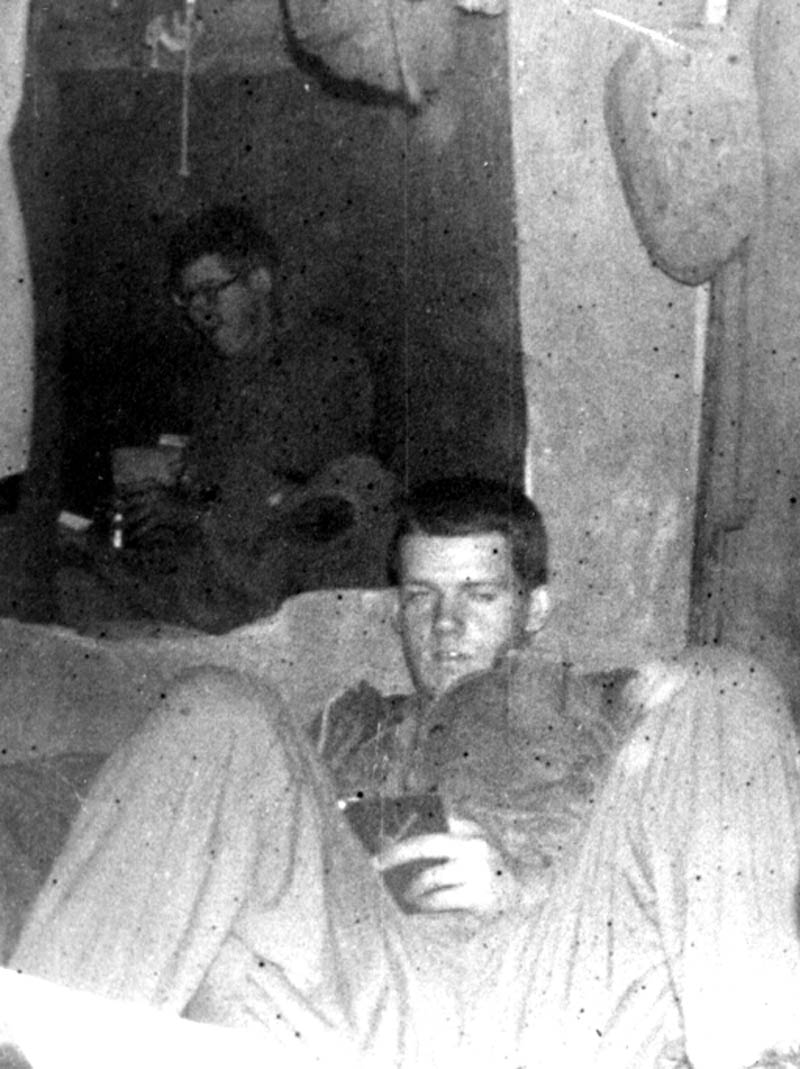
Dave Doehrman
On the morning of January 21, 1968 I was just getting a "wake up call" from the guy walking "fire watch" in the Company area. About 6 days before, one of the rats in our tent bit me on the hand and I was placed on mess duty while receiving a series of rabies shots. Since I wasn't able to go out on patrol I was assigned to mess duty and had to be at the mess hall at 0530. Just as I was sitting up, we heard the first incoming rounds start to impact inside the base. Someone shouted "incoming" and everyone started heading for the bunker next to the tent. I was awake, and was the first out the door. About half way to the bunker I realized I hadn't grabbed my rifle or gas mask. I turned to go back inside the tent, but the fellows inside shoved me toward the bunker and we all dove head first into the opening. For the first few minutes the incoming rounds didn't seem too bad. A few rounds had landed near our area and a couple fellows near the entrance were going to run back to the tent to grab our rifles and gear. That's when the main ammo dump blew. At first we didn't know what had happened. We all seemed to bounce straight up in the air and slammed back into the floor of the bunker. The air was thick with dust and we didn't know if we took a direct hit on the bunker or if a round had landed close by. Burning artillery rounds started falling into the area and that's when someone realized the ammo dump blew. The main ammo dump was only a couple hundred yards away and the initial shock wave leveled all the tents in the recon area. Burning rounds were laying all over and a few exploded when they landed. Ernie Husted and Louie DeLuca dashed into the remains of the tent and grabbed any rifles or gear they could find. A few minutes later we heard someone shouting "gas". The fires in the ammo dump had set off huge supples of CS (tear gas) ammunition and grenades. Clouds of gas were drifting into the area and we only had one gas mask for the ten people in our bunker. We took turns sharing the mask but it didn't help too much, the gas was too thick. By now, the secondary explosions from the ammo dump had started to slow down. A few of the guys left the bunker and soon we all crawled out into what was left of our area. Less than 2 hours before, we had a nice company area. Now all that was left was trash and rubble. A couple of the hootches along the road were still standing, but the walls were riddled with holes and the roofs had been blown away. For the next three months, we joined the rats in our holes in the ground.

Robert Pisor describes the recon area in his book, "The End of the Line": "The heart of the combat base, and the enemy's prime target, was the tight cluster of bunkers and tents next to the cargo offloading area, including Colonel Lownds' command post, Charlie Med, the ground control radar facilities, the radio relay center, and trenches for outbound air passengers.
Here too, was Khe Sanh's emergency reserve - a demoralized reconnaissance company whose only duty was to sit and be pounded until called to repel an enemy breakthrough.
Many rifles have an etched steel V for a rear sight and a perfect round bead for the front sight. A marksman sets the bead on the shoulder of a deer, or the neck of a squirrel, snugs the bead in the apex of the V and smoothly squeezes the trigger. To be in the V-ring is to be dead.
The 3rd Marine Divisions reconnaissance company was camped in the V-ring.
This proud outfit boasted it was 'The Eyes of the 26th Marines' - point man for the whole division. Its men usually operated in small teams far from friendly lines, and its banner was a grinning skull and crossed bones, with the motto 'Swift, Deadly, Silent.'
The recon teams had taken heavy casualties in January, and since January 20 all patrols had been limited to a few hundred yards or straight line of sight - whichever was less. Now the elite recon Marines huddled in bunkers, 'in reserve.' More than half the men in the company had been wounded or killed by mid-February - or evacuated when their eyes locked in 'the thousand-yard stare'."
In "Never Without Heros" Lawrence Vetter, Jr. writes: "Sixty-three percent of the battalion's 106 casualties were sustained by Bravo Company at Khe Sanh, where it was forced into bunkers for much of the month; twelve Bravo Reconners were killed and fifty-six wounded during those thirty-one days, most as a result of the continuous enemy rocket, mortar, and artillery attacks."
Both accounts make it sound like all we did was sit in the bunkers. In fact, the only time we spent in the bunkers was when the base was being shelled or at night while sleeping. During the day the men from Bravo Company were assigned to work detail all over the base. Some worked in the demolished ammo dump, picking up unexploded artillery rounds and placing them in piles to be destroyed, others worked as stretcher bearers at Charlie Med carrying wounded and dead to and from the helicopters, a few were sent to the "drop zone' to recover supplies being dropped in by parachute and anyone not on the working parties was adding layer after layer of sandbags to the bunkers in the recon area.
Distance wasn't measured in feet or yards; it was measured by running leaps to the nearest bunker entrance. As we walked the base, everyone kept their eyes open for the nearest bunker. We had at least one bunker in sight and usually knew where two or three more were located. After a few weeks the entire base resembled scenes from WWI. Trenches six feet deep connected most of the bunkers and we stayed in the trenches as much as possible while moving through our area, but it wasn't possible to stay underground on the working parties.
Of all the recon KIAs, only four were in bunkers when they died. On the evening of January 24, a 122mm rocket with a delayed fuse dropped directly into the entrance to one of the recon bunkers with 22 men inside. Four men died and the rest were wounded. The four who died were: HN Charles Wayne Miller, LCPL Gregory Francis Popowitz, LCPL Juan Antonio Rosa and LCPL Gary David Scribner.

This photo was taken inside our bunker. Lt. Mike Waddell is in the foreground and
Ernie "Preacher" Husted is in the background, cooking c-rats.